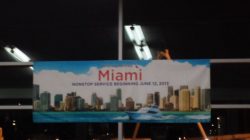This is probably the best news I have heard pertaining to DFW airport in over a decade.
Well, the day Qantas announced it was flying to Dallas/Ft. Worth, nonstop from Australia, comes very close in second place. However, TWO new routes from North Texas to mainland China and Hong Kong is something unprecedented. Never in the history of Dallas/Ft. Worth’s epic, rich aviation chronicles has anything come close to this large.
Take that, Houston.
Not even 20 minutes ago, American Airlines announced it will launch its first ever nonstop service from Dallas/Ft. Worth to Hong Kong Chep Lap Kok Int’l airport and Shanghai Pu Dong International airport next summer.
The DFW-HKG flight will operate on one of American’s new Boeing 777-300ER airframes, and the DFW-SHA flight will be on a Boeing 777-200ER. American’s Boeing 777-200 series aircraft is slated for a cabin redesign from a 3-class configuration to a 2-class configuration in the near future, with the elimination of the First class section. With a reduced premium cabin layout, American hope to improve yields on routes where it deploys its 777-200 series planes.
An unofficial “source” leaked the proposed schedule times on FlyerTalk for the new routes from boardingarea.com, but nothing has been confirmed.
My guess would be that the outbound DFW-HKG flight will leave around mid-day, arriving into Hong Kong the following evening (and facilitate inbound and outbound connections into DFW and ex-HKG) with a similar afternoon departure from HKG on the return and late afternoon arrival into DFW, same-day.
The DFW-PVG (IATA code for Shanghai) flight will probably leave late-morning and arrive mid-afternoon into Shanghai the following day, and return departing Shanghai in the late afternoon and arriving into DFW in mid-afternoon, same day.
The reconfigured 777-200 series planes will still feature American’s new Business Class seats to cater to the elite traffic on its long-haul routes. Moreover, the addition of Main Cabin Extra across its wide and narrowbody fleet has helped American cater to the demand of a “premium economy class” seat that offers extra legroom for passengers willing to pay more for an enhanced Coach class product, but not for a Business class seat, and will be available for purchase on both of these new routes.
American’s 777-300ER planes, however, will retain First Class, and is being deployed on some of its more ‘premium-heavy’ routes to cities such as London Heathrow, Sao Paulo and now, Hong Kong.
The new DFW routes will help American win in the TransPac market
American is frequently criticized for its lackluster revenue and yield performance on its transpacific US-Asia routes. Currently, American flies to Tokyo Narita, Tokyo Haneda, Beijing, Shanghai and Seoul airports from four of five of its ‘cornerstone’ hubs: Dallas/Ft. Worth, Chicago O’Hare, Los Angeles and New York JFK. In the past, it has failed in certain Asia markets, namely Delhi, Taipei, Osaka and Nagoya, Japan.
To that point, today’s news did also come with a somber announcement that American will quietly exit from serving Tokyo Haneda airport on December 1, which it currently flies nonstop from New York JFK. After a lengthy battle with the US DOT to receive landing slots to the restricted Haneda airport in 2010, located much closer to the central business district of Tokyo, American has struggled to meet revenue and yield expectations due to poorly-allocated departure and arrival times at HND. Moreover, the sagging transpacific market has hurt the performance on this route.
However, in my opinion, the odds are for American on its new DFW-Asia routes
Some implications are obvious: first, the business ties between Texas and Asia are growing stronger each year, coupled with increasing foreign visitors to the Dallas/Ft. Worth metropolitan area. Dallas has proved to be a relatively recession-proof city, thereby reducing risk when considering movement in the ultra-long haul flight space.
Moreover, from an air service development perspective, there are some good praises Dallas/Ft. Worth ought to be singing to the world at the moment.
For one, there is no existing competition from North Texas, or anywhere in the South/Southwest region, to either Shanghai or Hong Kong. Existing DFW-Asia routes have been relatively successful, despite the general volatilty of Asia-Pac markets. American has sustained two daily nonstop flights to Tokyo Narita for over a decade, and recently added a nonstop flight to Seoul earlier this year. Korean Air has been a long time carrier serving the DFW market since 1994, despite the absence of a SkyTeam hub at the DFW end. KE has gradually increased frequencies over the years to a daily service, with plans to up-gauge capacity from a 772 to a larger-seating 77W in coming months.
American will benefit from connecting DFW to another OneWorld alliance hub at Hong Kong, home of OneWorld member Cathay Pacific airlines. While a DFW-HKG flight on Cathay Pacific metal was long-rumored, it’s no secret that Cathay is generally coy about venturing into new intercontinental routes. As I reported last week, while CX is reaping the benefits of a stabilizing North American premium long-haul market, reporting higher yields and load factors on their existing routes, they have only chosen to increase services and frequencies to markets they already serve, namely New York, Chicago and Los Angeles, rather than open up new ones.
Therefore, it was a ripe opportunity for AA to jump on the route, and both airlines will benefit from connecting traffic and feed on both ends.
Leveraging DFW’s power as a global connecting hub
If I had to make an off-hand guess, I sense that American’s big plans for DFW somewhat follows what Delta has in store for Seattle in terms of creating SEA-TAC to be Delta’s gateway to Asia. Back in the mid-2000’s, Chicago was originally intended to serve as AA’s primary AAsia gateway, but that strategy has largely been a major flop. Timing was less than ideal given the 2008 financial crisis, skyrocketing crude oil prices and American’s weakened hub position at O’Hare competing against a newly merged, 800lb gorilla, United Airlines, for market share. Prior to filing for Chapter 11 bankruptcy protection in November 2011, American’s labor cost structure was also highly uncompetitive, and these contracts have been jettisoned and re-written during the restructuring proceedings.
Bolstened without a major nearby competitor, and serving as the largest hub to a leaner, meaner American, its hometown airline, DFW airport has taken that throne, at least in the interim, from ORD.
I believe that American has learned a lesson from Delta, and one that Delta learned from United: the key is isolating which hub provides the most potential for a sustainable gateway and making the necessary product, infrastructure and network investments to proceed from there.
It’s worth mentioning that AA had better make said investments now rather than later, and watching the competition further preclude its hopes from ever expanding. If one thing is for certain, a merger with US Airways definitely would not have helped make this happen (considering that whole plan may go south, anyways). In general, airlines tend to grow their networks during or after exiting bankruptcy, after clearing house, and not after mergers. Mergers do not create capacity: restructuring is what enables airlines to develop new routes.
For Asia-Pac, from a hub perspective, United has always had SFO, which is hard to beat. Delta has made it clear that Seattle will be their springboard for Japan, China, Korea and beyond. Now, Dallas/Ft. Worth will be the case for American in Asia.
Once these two new routes come online, DFW will provide the largest number of nonstops to Asia out of the 5 cornerstone hubs: 2 daily flights to Tokyo, and one each to Seoul, Shanghai and Hong Kong. All that is missing is Beijing, which is not out of the question.
To add to the mix, American Airlines has a vibrant Latin American route network from its DFW hub. It’s not Miami, but DFW can take you most of the major cities south of the border, recently adding Bogota, Colombia and Lima, Peru to its list of growing nonstop destinations, in addition to the existing Santiago, Buenos Aires, Sao Paulo, Caracas, Rio de Janeiro, Mexico City, Panama, and many others in Mexico and Central America. These two new routes will be well-timed to ideally connect passengers to Latin America.
This has, and will be, American’s “ace-in-the-hole” paving the way for success on its DFW-Asia routes.
Just watch and see. I’m willing to bet my money on it.
Finally, still relevant to mention has been the success of recent additions to DFW’s long-haul international reach. Qantas Airlines launched DFW in May 2011 initially on a 3-weekly flight basis, and eventually up-gauged the flight to a daily service within a single calendar year. Emirates Airline of Dubai will be approaching its 2-year anniversary serving DFW early next spring, and will likely also up-gauge this route to a larger-density 777-300ER as it matures. For an airport located in a mid-continent region, these are a pretty big deal.
On a smaller scale level, DFW airport has also successfully attracted transborder service on a few other North American carriers, such as WestJet (Canada), AeroMexico, Cayman Airways and a few other seasonal and charter providers to leisure and sun destinations.
With a world-class, state-of-the-art International Terminal D and an efficient Automated People Mover system in place since 2005, it is no doubt that DFW airport is one of the best for international and domestic connections.
I’ve been dreaming of days like this since I was in high school, and today, it’s really nice to see my hometown airport finally see its hard work pay off. Congrats to American, OneWorld, and most importantly, the People working hard to invest in the future of Dallas/Ft. Worth Int’l airport. My hats are off in salute.




